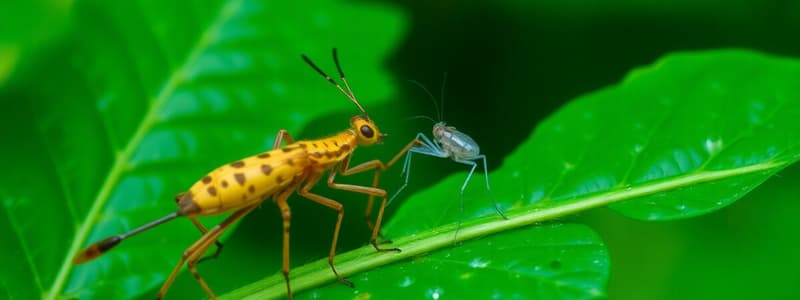Podcast
Questions and Answers
What is the term for a population with multiple distinct forms or morphs?
What is the term for a population with multiple distinct forms or morphs?
- Polymorphic (correct)
- Monomorphic
- Heterozygous
- Diploid
Reproductively isolated species can still exchange genetic material.
Reproductively isolated species can still exchange genetic material.
False (B)
What happens to the population when a pollinator that prefers medium height plants disappears?
What happens to the population when a pollinator that prefers medium height plants disappears?
The medium height plants would be selected against, and the population would shift towards short and tall plants.
The process resulting in the formation of two new separate species is known as __________.
The process resulting in the formation of two new separate species is known as __________.
Match the pollinator preferences with their effects on plant populations:
Match the pollinator preferences with their effects on plant populations:
Which type of isolation occurs when two species mate during different seasons?
Which type of isolation occurs when two species mate during different seasons?
Behavioural isolation can occur when two species use the same mating call.
Behavioural isolation can occur when two species use the same mating call.
What must occur for one species to split into two?
What must occur for one species to split into two?
Two species living in the same habitat but preferring different conditions exhibit __________ isolation.
Two species living in the same habitat but preferring different conditions exhibit __________ isolation.
Match the type of isolation with its example:
Match the type of isolation with its example:
What results from reproductive isolation affecting different populations?
What results from reproductive isolation affecting different populations?
Two species of frogs can use the same habitat but still remain reproductively isolated.
Two species of frogs can use the same habitat but still remain reproductively isolated.
Provide an example of behavioural isolation in animals.
Provide an example of behavioural isolation in animals.
What is the process called when organisms can no longer interbreed with the original species?
What is the process called when organisms can no longer interbreed with the original species?
Allopatric speciation involves the separation of populations due to a physical barrier.
Allopatric speciation involves the separation of populations due to a physical barrier.
What type of reproductive isolation occurs when two populations prefer different food sources?
What type of reproductive isolation occurs when two populations prefer different food sources?
The type of speciation that occurs without a physical barrier is called __________.
The type of speciation that occurs without a physical barrier is called __________.
Match the following types of isolation to their definitions:
Match the following types of isolation to their definitions:
Which of the following is a characteristic of allopatric speciation?
Which of the following is a characteristic of allopatric speciation?
Sympatric speciation is primarily driven by geographical barriers.
Sympatric speciation is primarily driven by geographical barriers.
Flashcards
Polymorphic population
Polymorphic population
A population with multiple distinct forms or morphs.
Speciation
Speciation
The process by which new species arise from existing ones.
Species
Species
A group of organisms that can breed together to produce fertile offspring.
Natural Selection
Natural Selection
Signup and view all the flashcards
Disruptive Selection
Disruptive Selection
Signup and view all the flashcards
Reproductive Isolation
Reproductive Isolation
Signup and view all the flashcards
Geographical Isolation
Geographical Isolation
Signup and view all the flashcards
Temporal Isolation
Temporal Isolation
Signup and view all the flashcards
Behavioral Isolation
Behavioral Isolation
Signup and view all the flashcards
Ecological Isolation
Ecological Isolation
Signup and view all the flashcards
Selective Pressures
Selective Pressures
Signup and view all the flashcards
Evolution
Evolution
Signup and view all the flashcards
Divergent Evolution
Divergent Evolution
Signup and view all the flashcards
Allopatric Speciation
Allopatric Speciation
Signup and view all the flashcards
Sympatric Speciation
Sympatric Speciation
Signup and view all the flashcards
Habitat Isolation
Habitat Isolation
Signup and view all the flashcards
Evolutionary Changes in Speciation
Evolutionary Changes in Speciation
Signup and view all the flashcards
Natural Selection in Speciation
Natural Selection in Speciation
Signup and view all the flashcards
Study Notes
Speciation
- Species: groups of organisms that can interbreed to produce fertile offspring; reproductively isolated, no genetic exchange
- Problems with the definition: some organisms that reproduce differently can produce fertile offspring (e.g., the "pizzly bear")
- How does one species split into two? Reproductive isolation is required.
How Species Split
- Geographic isolation (allopatric speciation):
- Physical barriers (e.g., rivers, mountain ranges) separate populations
- Different environments lead to different selective pressures
- Adaptations to different environments over time result in the populations becoming separate species
- Sympatric speciation:
- No physical barrier
- One population splits into two based on factors like differences in habitat use, mating seasons, food preferences
- Same process as allopatric speciation but no geographical separation
- Conditions for life are different leading to separate adaptation patterns
Types of Speciation
- Allopatric speciation: Happens when a physical barrier separates a population into groups—leading to geographical isolation.
- Sympatric speciation: One population separates into groups based on something other than a physical barrier.
Divergent Evolution
- One species becomes two through reproductive isolation.
- Species originate from common ancestors.
- Similarities between species decrease over time.
- Adaptive radiation: one ancestral species becomes many new species; it can be a result of the founder effect (a small group splinters off and starts a new colony).
Convergent Evolution
- Species do not evolve from the same ancestor but look similar (analogous structures)
- Adaptations that work well in an environment become more prevalent.
How Quickly Does Speciation Happen?
- Gradualism: New species arise from many small changes over long periods.
- Punctuated Equilibrium: Major environmental changes allow rapid speciation events.
Studying That Suits You
Use AI to generate personalized quizzes and flashcards to suit your learning preferences.




